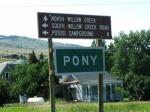
最近、米国のゴーストタウンをリストアップしたサイトを見つけた。サイトは州別に区分されており、さらに各カウンティ(郡)ごとにインタラクティヴマップが用意されている。モンタナに限らず、このブログで紹介してきたゴーストタウンも散見されるので、御覧あれ。
そんなわけで先日の日曜日は部屋の掃除や洗濯を終えた後にどこに行こうかとこのサイトを物色していたのであった。そして目に留まったのが、隣のカウンティにあるPonyという町だ。サイトには写真も掲載されており、なかなかよさげな雰囲気の廃屋も建っている。そしてなによりも午後から出かけるにはちょうど良い距離でもあるわけだ。
またクルマのエアコンを修理してから長距離のドライブにも出ていなかったので、乗り心地をチェックするためにもチョット遠出をしたいとゆーことも附記しておこう。
Pony自体はゴールドラッシュの時代に金鉱から掘り出された岩石を処理するために設置された町だったらしい。多くの人たちが働いていたとか。
 |  | 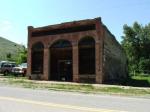 |
| 丘から町を臨む | 銀行のあと | たぶん倉庫 |
以下はミルの廃墟の前にあった説明文だ。
Elling-Morris-Mills Two coarse rubble stone walls, wooden walls extending above and beyond the stone walls at the rear, and a wooden roof housed this twenty-stamp gold mill built in 1883. Henry Elling (1848-1900) and William W. Morris (1840-1904) were the mill’s original owners. Each of the mill’s twenty stamps probably weighed between 500 and 750 pounds. Lifted in sequence by a camshaft, the giant stamps crushed gold-bearing quartz into fine sand. The quartz came from Pony-area mines, including the Boss Tweed, the Keystone, and the Clipper. Once crushed, the ore was placed on one of the mill’s four Frue vanners. New technology in1884, Frue vanners combined a shaking rubber belt with water jets to wash away “gangue” (worthless rock) while leaving the heavier gold-containing particles. The gold-containing particles were then shipped approximately sixty miles north to a smelter at Wickes, where giant roasting furnaces finished the process of isolating the gold. Once the largest operating concentrator in Pony, the mill ran periodically from 1884 until approximately 1926. Today only the east and west walls remain.
このミル小屋跡は銀行跡の先にある砂利道をすすむとある。
 | 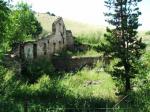 | 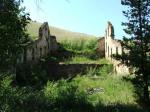 |
実際のところ、このPony、そんなにゴーストタウンっぽくない。ナゼかと言えば町のまんなかに未だに営業しているバーがあるのだ。またかずおおくの新しい家が周りに建てられており、どちらかといえば隠された高級リゾートといった感じだ。その中にちらほらと廃墟があるわけ。
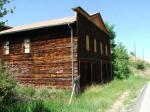 |  |  |
しかしながらなぜココがリゾートとして好まれるのか?それはたぶん、ただでさえ時間がゆっくりと進むモンタナの雰囲気のなかでこのPONYはさらに緩やかな時間のながれの中を漂っているからなのかもしれない。
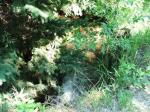 |  |








